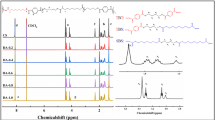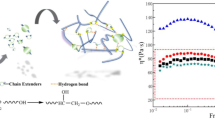Abstract
Linear 1,10-decanediamine was chosen as a modified monomer to prepare modified poly(ethylene terephthalate) (PET) with a low content of amide bonds through two different synthetic methods. To evaluate the effect of amide bonds on the properties of poly(ester amide) analogs (PETAs), the performance of this new type of PET was compared with 1,10-decanediol-modified PET as a control group. The formation of hydrogen bonds in the PETAs was confirmed, and the stability of hydrogen-bonding interactions based on the low content of amide bonds at high temperature was discussed. Interestingly, physical cross-linking networks formed by hydrogen-bonding interactions improved the thermal stability, rheology, and mechanical properties of the PETAs. The crystallization properties were studied in depth by a series of tests, the results of which illustrated that the low content of amide bonds acted as a critical crystallization accelerator in the PETAs. A feasible strategy to prepare high-performance PET, which may be used as a packaging material, was introduced in this work.
Graphical abstract












Similar content being viewed by others
References
Wang P, Wang M, Liu F, Ding S, Wang X, Du G, Liu J, Apel P, Kluth P, Trautmann C, Wang Y (2018) Ultrafast ion sieving using nanoporous polymeric membranes. Nat Commun 9(1):569. https://doi.org/10.1038/s41467-018-02941-6
Cao W, Wei D, Jiang Y, Ye S, Zheng A, Guan Y (2018) Surface chemical bonding with poly(hexamethylene guanidine) for non-leaching antimicrobial poly(ethylene terephthalate). J Mater Sci 54(3):2699–2711. https://doi.org/10.1007/s10853-018-2966-0
Babaahmadi V, Montazer M, Gao W (2017) Low temperature welding of graphene on PET with silver nanoparticles producing higher durable electro-conductive fabric. Carbon 118:443–451. https://doi.org/10.1016/j.carbon.2017.03.066
Wang Y, Zhao J, Sha L, Zhu Y, Li X (2017) Design of broad-spectrum antimicrobial polyethylene terephthalate fabrics by coating composited natural brucites. J Mater Sci 53(3):1610–1622. https://doi.org/10.1007/s10853-017-1648-7
Zhang X, Zhao S, Mohamed MG, Kuo S, **n Z (2020) Crystallization behaviors of poly(ethylene terephthalate) (PET) with monosilane isobutyl-polyhedral oligomeric silsesquioxanes (POSS). J Mater Sci 55(29):14642–14655. https://doi.org/10.1007/s10853-020-05003-9
Luo J, Ma N, Zeng S, Gong X, Shi B, Li C, Zhao X, Hu T, Wu C (2018) Effect of ionization of polyamide-66 on its heterogeneous nucleation of poly(ethylene terephthalate) crystallization: an efficient polyamide-66 ionene nucleator promoted by ion-dipole interactions. Polym Test 71:301–311. https://doi.org/10.1016/j.polymertesting.2018.09.014
Tong Z, Zhuo W, Zhou J, Huang R, Jiang G (2017) Crystallization behavior and enhanced toughness of poly(ethylene terephthalate) composite with noncovalent modified graphene functionalized by pyrene-terminated molecules: a comparative study. J Mater Sci 52(17):10567–10580. https://doi.org/10.1007/s10853-017-1173-8
Sun S, Wang L, Song P, Ding L, Bai Y (2017) Facile fabrication of hydrolysis resistant phosphite antioxidants for high-performance optical PET films via in situ incorporation. Chem Eng J 328:406–416. https://doi.org/10.1016/j.cej.2017.07.070
Yang YK, Bae SB, Hwang YT (2013) Novel catalysts based on zirconium(IV) for the synthesis of poly(ethylene terephthalate-co-isophthalate) copolyesters. Tetrahedron Lett 54(10):1239–1242. https://doi.org/10.1016/j.tetlet.2012.12.098
Mao Z, Li J, Pan F, Zeng X, Zhang L, Zhong Y, Sui X, Xu H (2015) High-temperature auto-cross-linking cyclotriphosphazene: synthesis and application in flame retardance and antidrip** poly(ethylene terephthalate). Ind Eng Chem Res 54(15):3788–3799. https://doi.org/10.1021/ie504510t
Wu JN, Chen L, Fu T, Zhao HB, Guo DM, Wang XL, Wang YZ (2018) New application for aromatic schiff base: high efficient flame-retardant and anti-drip** action for polyesters. Chem Eng J 336:622–632. https://doi.org/10.1016/j.cej.2017.12.047
Hu YS, Prattipati V, Mehta S, Schiraldi DA, Hiltner A, Baer E (2005) Improving gas barrier of PET by blending with aromatic polyamides. Polymer 46(8):2685–2698. https://doi.org/10.1016/j.polymer.2005.01.056
Joshi AS, Lawrence JG, Coleman MR (2019) Effect of Biaxial Orientation on microstructure and properties of renewable copolyesters of poly(ethylene terephthalate) with 2,5-furandicarboxylic acid for packaging application. ACS Appl Polym Mater 1(7):1798–1810. https://doi.org/10.1021/acsapm.9b00330
**e L, **e Y, Wu Q, Wang M, Wu Q, Zhou X, Ge X (2015) Effect of poly(acrylic acid)-modified poly(ethylene terephthalate) on improving the integrated mechanical properties of poly(ethylene terephthalate)/elastomer blend. Ind Eng Chem Res 54(17):4748–4755. https://doi.org/10.1021/acs.iecr.5b00091
Ding L, Liu L, Chen Y, Du Y, Guan S, Bai Y, Huang Y (2019) Modification of poly(ethylene terephthalate) by copolymerization of plant-derived α-truxillic acid with excellent ultraviolet shielding and mechanical properties. Chem Eng J 374:1317–1325. https://doi.org/10.1016/j.cej.2019.05.224
Lechat C, Bunsell AR, Davies P (2010) Tensile and creep behaviour of polyethylene terephthalate and polyethylene naphthalate fibres. J Mater Sci 46(2):528–533. https://doi.org/10.1007/s10853-010-4999-x
Chowreddy RR, Nord-Varhaug K, Rapp F (2018) Recycled polyethylene terephthalate/carbon nanotube composites with improved processability and performance. J Mater Sci 53(9):7017–7029. https://doi.org/10.1007/s10853-018-2014-0
Ju L, Dennis JM, Heifferon KV, Long TE, Moore RB (2019) Compatibilization of polyester/polyamide blends with a phosphonated poly(ethylene terephthalate) ionomer: comparison of monovalent and divalent pendant ions. ACS Appl Polym Mater 1(5):1071–1080. https://doi.org/10.1021/acsapm.9b00097
Novello MV, Carreira LG, Canto LB (2014) Post-consumer polyethylene terephthalate and polyamide 66 blends and corresponding short glass fiber reinforced composites. J Mater Res 17(5):1285–1294. https://doi.org/10.1590/1516-1439.281914
Evstatiev M, Nicolov N, Fakirov S (1996) Morphology of microfibrillar reinforced composites PET/PA 6 blend. Polymer 37(20):4455–4463. https://doi.org/10.1016/0032-3861(96)00137-1
Serhatkulu T, Erman B, Bahar I, Fakirov S, Evstatiev M, Sapundjieva D (1995) Dynamic mechanical study of amorphous phases in poly(ethylene terephthalate)/nylon-6 blends. Polymer 36(12):2371–2377. https://doi.org/10.1016/0032-3861(95)97335-D
Yan Y, Gooneie A, Ye H, Deng L, Qiu Z, Reifler FA, Hufenus R (2018) Morphology and crystallization of biobased polyamide 56 blended with polyethylene terephthalate. Macromol Mater Eng 303(9):1800214. https://doi.org/10.1002/mame.201800214
Tanaka FH, Cruz SA, Canto LB (2018) Morphological, thermal and mechanical behavior of sepiolite-based poly(ethylene terephthalate)/polyamide 66 blend nanocomposites. Polym Test 72:298–307. https://doi.org/10.1016/j.polymertesting.2018.10.027
Retolaza A, Eguiazábal JI, Nazábal J (2004) Structure and mechanical properties of polyamide-6,6/poly(ethylene terephthalate) blends. Polym Eng Sci 44(8):1405–1413. https://doi.org/10.1002/pen.20136
Khoshnevis H, Zadhoush A (2012) The influence of epoxy resin on the morphological and rheological properties of PET/PA66 blend. Rheol Acta 51(5):467–480. https://doi.org/10.1007/s00397-011-0615-5
Winnacker M, Rieger B (2016) Poly(ester amide)s: recent insights into synthesis, stability and biomedical applications. Polym Chem 7(46):7039–7046. https://doi.org/10.1039/c6py01783e
Fonseca AC, Gil MH, Simões PN (2014) Biodegradable poly(ester amide)s – a remarkable opportunity for the biomedical area: review on the synthesis, characterization and applications. Prog Polym Sci 39(7):1291–1311. https://doi.org/10.1016/j.progpolymsci.2013.11.007
Li CG, Li SQ, Zhao JB, Zhang ZY, Zhang JY, Yang WT (2015) Synthesis and characterization of segmented poly(ether ester amide)s from diglycol, adipic acid, and a nylon-6 oligomer. Polym Eng Sci 55(4):763–770. https://doi.org/10.1002/pen.23944
Soleimani A, Drappel S, Carlini R, Goredema A, Gillies ER (2014) Structure-property relationships for a series of poly(ester amide)s containing amino acids. Ind Eng Chem Res 53(4):1452–1460. https://doi.org/10.1021/ie4035219
Lynch JG, Jaycox GD (2014) Stimuli-responsive polymers. 10. Photo-regulation of optical rotations in azobenzene modified poly(ester-amide)s containing highly structured, atropisomeric backbone geometries. Polymer 16:3564–3572. https://doi.org/10.1016/j.polymer.2014.06.065
Basterretxea A, Gabirondo E, Sanchez-Sanchez A, Etxeberria A, Coulembier O, Mecerreyes D, Sardon H (2017) Synthesis and characterization of poly (ε-caprolactam-co-lactide) polyesteramides using Brønsted acid or Brønsted base organocatalyst. Eur Polym J 95:650–659. https://doi.org/10.1016/j.eurpolymj.2017.05.023
Mejia JS, Gillies ER (2013) Triggered degradation of poly(ester amide)s via cyclization of pendant functional groups of amino acid monomers. Polym Chem 4(6):1969. https://doi.org/10.1039/c3py21094d
Lebarbé T, Maisonneuve L, Nga Nguyen TH, Gadenne B, Alfos C, Cramail H (2012) Methyl 10-undecenoate as a raw material for the synthesis of renewable semi-crystalline polyesters and poly(ester-amide)s. Polym Chem 3(10):2842. https://doi.org/10.1039/c2py20394d
Kluge M, Rennhofer H, Lichtenegger HC, Liebner FW, Robert T (2020) Poly(ester amide)s from poly(alkylene succinate)s and rapid crystallizing amido diols: synthesis, thermal properties and crystallization behavior. Eur Polym J 129:109622. https://doi.org/10.1016/j.eurpolymj.2020.109622
Gupta S, Yuan X, Chung TCM, Kumar S, Cakmak M, Weiss RA (2013) Effect of hydroxyl-functionalization on the structure and properties of polypropylene. Macromolecules 46(14):5455–5463. https://doi.org/10.1021/ma4008658
Gupta S, Yuan X, Chung TCM, Cakmak M, Weiss RA (2014) Isothermal and non-isothermal crystallization kinetics of hydroxyl-functionalized polypropylene. Polymer 55(3):924–935. https://doi.org/10.1016/j.polymer.2013.12.063
Misra M, Agarwal M, Sinkovits DW, Kumar SK, Wang C, Pilania G, Ramprasad R, Weiss RA, Yuan X, Chung TCM (2014) enhanced polymeric dielectrics through incorporation of hydroxyl groups. Macromolecules 47(3):1122–1129. https://doi.org/10.1021/ma402220j
Ni Y, Li Q, Chen L, Wu W, Qin Z, Zhang Y, Chen L, Wang X, Wang Y (2019) Semi-aromatic copolyesters with high strength and fire safety via hydrogen bonds and π-π stacking. Chem Eng J 374:694–705. https://doi.org/10.1016/j.cej.2019.05.212
Kaczmarczyk B (1998) FT ir study of hydrogen bonds in aliphatic polyesteramides. Polymer 39(23):5853–5860. https://doi.org/10.1016/S0032-3861(98)00024-X
Gao H, Bai Y, Liu H, He J (2019) Mechanical and gas barrier properties of structurally enhanced poly(ethylene terephthalate) by introducing 1,6-hexylenediamine unit. Ind Eng Chem Res 58(47):21872–21880. https://doi.org/10.1021/acs.iecr.9b04953
Hu H, Zhang R, Sousa A, Long Y, Ying WB, Wang J, Zhu J (2018) Bio-based poly(butylene 2,5-furandicarboxylate)-b-poly(ethylene glycol) copolymers with adjustable degradation rate and mechanical properties: synthesis and characterization. Eur Polym J 106:42–52. https://doi.org/10.1016/j.eurpolymj.2018.07.007
Marcel K, Dimitrios NB, Tobias R (2019) Enhancing the properties of poly(propylene succinate) by the incorporation of crystallizable symmetrical amido diols. Eur Polym J 120:109195. https://doi.org/10.1016/j.eurpolymj.2019.08.022
Jeziorny A (1978) Parameters characterizing the kinetics of the non-isothermal crystallization of poly(ethylene terephthalate) determined by d.s.c. Polymer 19:1142–1144. https://doi.org/10.1016/0032-3861(78)90060-5
Wang Q, Zhang F, Qu D, Bai Y (2018) The effect of crystallization properties influenced by 2-methyl-1,3–propanediol units on the optical properties of modified poly(ethylene terephthalate). High Perform Polym 31(2):211–219. https://doi.org/10.1177/0954008318758490
Mo Z (2008) A method for the non-isothermal crystallization kinetics of polymers. Acta Polym Sin 7:656–661. https://doi.org/10.3724/SP.J.1105.2008.00656
Ozawa T (1971) Kinetics of non-isothermal crystallization. Polym 12:150–158. https://doi.org/10.1016/0032-3861(71)90041-3
Orencha IP, Stribeck N, Ania F, Baer E, Hiltner A, Calleja FJB (2009) SAXS study on the crystallization of PET under physical confinement in PET/PC multilayered films. Polymer 50:2680–2687. https://doi.org/10.1016/j.polymer.2009.03.040
Acknowledgements
This research did not receive any specific grant from funding agencies in the public, commercial, or not-for-profit sectors.
Author information
Authors and Affiliations
Corresponding authors
Ethics declarations
Conflict of interest
The authors declare that they have no conflict of interest.
Additional information
Handling Editor: Gregory Rutledge.
Publisher's Note
Springer Nature remains neutral with regard to jurisdictional claims in published maps and institutional affiliations.
Electronic supplementary material
Below is the link to the electronic supplementary material.
Rights and permissions
About this article
Cite this article
Gao, H., Liu, H., He, J. et al. Synthesis and properties of poly(ethylene terephthalate) modified with a small amount of 1,10-decanediamine and hydrogen bonds. J Mater Sci 56, 4922–4939 (2021). https://doi.org/10.1007/s10853-020-05590-7
Received:
Accepted:
Published:
Issue Date:
DOI: https://doi.org/10.1007/s10853-020-05590-7




